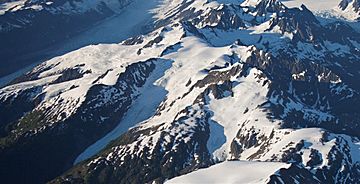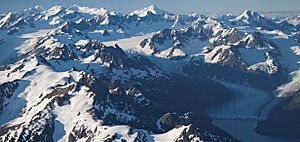Mount Castner facts for kids
Quick facts for kids Mount Castner |
|
|---|---|

Aerial view of west aspect
|
|
| Highest point | |
| Elevation | 5,535 ft (1,687 m) |
| Prominence | 585 ft (178 m) |
| Isolation | 1.41 mi (2.27 km) |
| Parent peak | Peak 6140 |
| Geography | |
| Location | Chugach National Forest Valdez-Cordova Borough Alaska, United States |
| Parent range | Chugach Mountains |
| Topo map | USGS Anchorage A-2 |
Mount Castner is a tall, icy mountain in Alaska. It's about 5,535 feet (1,687 meters) high and is part of the Chugach Mountains. This mountain is special because it rises very quickly from the ocean, making it look even taller! It's located in the Chugach National Forest, a beautiful area managed by the United States government.
The mountain is found near the head of two glaciers, Ranney Glacier and Dartmouth Glacier. It's also very close to the waters of Unakwik Inlet and College Fjord, which are part of Prince William Sound. This means the mountain goes from sea level to over a mile high in just about three miles horizontally.
The name "Mount Castner" was given in 1910 by a geographer named Lawrence Martin. The United States Geological Survey, which maps the land, officially adopted the name. The mountain is named after Joseph Compton Castner (1869–1946). He was an important person who explored this area in 1898 with Captain Edwin Forbes Glenn.
Contents
Climate at Mount Castner
Mount Castner is in a subarctic climate zone. This means it has very long, cold, and snowy winters. The summers are usually mild, not too hot.
How Weather Forms Here
Weather systems from the Gulf of Alaska hit the Chugach Mountains. The mountains force the air upwards, which is called orographic lift. This process causes a lot of rain and snow to fall on the mountains.
Temperatures and Glaciers
During winter, temperatures can drop below −20 °C (which is −4 °F). With wind, it can feel even colder, sometimes below −30 °C (−22 °F). This cold climate helps keep the large glaciers around the mountain, like the Meares Glacier and Yale Glacier, frozen and active.
Best Time to Visit
If you want to see Mount Castner or try climbing it, the best time to visit is usually from May through June. The weather during these months is often the most pleasant.



